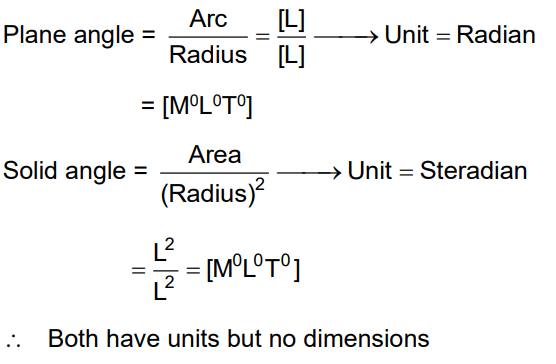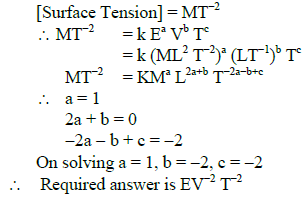NEET Previous Year Questions (2014-2025): Units & Measurements | Physics Class 11 PDF Download
2024
Q1: In a vernier callipers, (N + 1) divisions of vernier scale coincide with N divisions of main scale. If(a)

(b)

(c) 100N
(d) 10(N + 1)
Ans: (b)
V.C = MSD
given : (N + 1)
 ..... (2)
..... (2)From (1) and (2)
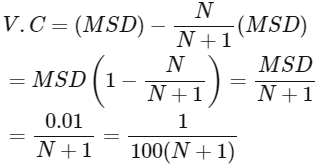
Q2: The quantities which have the same dimensions as those of solid angle are: [2024]
(a) strain and angle
(b) stress and angle
(c) strain and arc
(d) angular speed and stress
Ans: (a)
Solid angle
 has dimensions
has dimensions 
Strain

 has dimensions
has dimensions 
Angle measured in radians is also dimensionless


Q3: A force defined by
 acts on a particle at a given time t. The factor which is dimensionless, if α and β are constants, is: [2024]
acts on a particle at a given time t. The factor which is dimensionless, if α and β are constants, is: [2024](a) βt / α
(b) αt / β
(c) αβt
(d) αβ / t
Ans: (b)
From principle of homogeneity
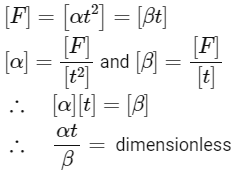
Q4: The percentage errors in the measurement of mass and momentum of an object are 1 % and 2 % respectively. The percentage error in the measurement of kinetic energy of the object will be: [2024]
(a) 1 %
(b) 3 %
(c) 4 %
(d) 5 %
Ans: (d)
The formula for kinetic energy (K.E.) of an object is:
K.E. = (1/2) × m × v²
where m is mass and v is velocity.
The momentum p is given by:
p = m v
⇒ v = p / m
Thus, the kinetic energy can be expressed as:
K.E. = (p²) / (2m)
Now, we calculate the percentage error in K.E. by using the formula for propagation of errors:
- Percentage error in K.E. = 2 × (percentage error in p) + (percentage error in m)
This is because the momentum p appears squared, and mass m appears linearly.
- Percentage error in K.E. = 2 × 2% + 1% = 4% + 1% = 5%.
Thus, the percentage error in the measurement of kinetic energy is 5%.
Q5: Match List- I with List- II. Choose the correct answer from the options given below: [2024]
Choose the correct answer from the options given below: [2024]
(a) A-III, B-II, C-I, D-IV
(b) A-III, B-I, CII, D-IV
(c) A-I, B-II, C-IV, D-III
(d) A-IV, B-I, C-II, D-III
Ans: (d)
To match the measured values with the correct number of significant figures, let's analyze each value:
A. 0.001213
This number has 4 significant figures (the leading zeros do not count). Hence, the correct option is IV (4 significant figures).
B. 2.1 × 1016
This number is written in scientific notation, and the coefficient (2.1) has 2 significant figures. Hence, the correct option is I (2 significant figures).
C. 3.70
This number has 3 significant figures because the trailing zero after the decimal point is significant. Hence, the correct option is II (3 significant figures).
D. 3000
This number can be ambiguous. Without a decimal point, the number of significant figures is usually considered to be 1 (based on standard conventions for scientific notation). Hence, the correct option is III (1 significant figure).
Thus, the correct matches are:
- A → IV (4 significant figures)
- B → I (2 significant figures)
- C → II (3 significant figures)
- D → III (1 significant figure)
The correct answer is (4) A-IV, B-I, C-II, D-III.
Q6: A vernier callipers has 1 mm marks on the main scale. It has 20 equal divisions on the vernier scale which match with 16 main scale divisions. The least count of this vernier calipers is: [2024]
(a) 0.02 mm
(b) 0.05 mm
(c) 0.10 mm
(d) 0.20 mm
Ans: (d)
To calculate the least count of the vernier calipers, we can use the following formula:
Least Count (LC) = Value of one main scale division (MSD) - Value of one vernier scale division (VSD)
Given:
- 1 main scale division (MSD) = 1 mm
- There are 20 equal divisions on the vernier scale, which match with 16 divisions on the main scale.
Now, let's find the value of one vernier scale division (VSD):
Since 20 divisions on the vernier scale match with 16 divisions on the main scale, we can write:
Value of 1 VSD = (16 MSD) / 20 = 16 mm / 20 = 0.8 mm
Thus, the value of one vernier scale division (VSD) is 0.8 mm.
Now, we can calculate the least count:
LC = 1 MSD - 1 VSD = 1 mm - 0.8 mm = 0.2 mm
Therefore, the least count of the vernier calipers is 0.2 mm.
The correct answer is (d) 0.20 mm.
2023
Q1: A metal wire has mass (0.4 ± 0.002) g, radius (0.3 ± 0.001) mm and length (5 ± 0.02) cm. The maximum possible percentage error in the measurement of density will nearly be [2023]
(a) 1.2%
(b) 1.3%
(c) 1.6%
(d) 1.4%
Ans: (c)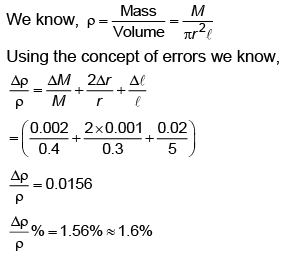
Q2: The diameter of a spherical bob, when measured with vernier callipers yielded the following values : 3.33 cm,3.32 cm,3.34 cm,3.33 cm and 3.32 cm. The mean diameter to appropriate significant figures is : [2023]
(a) 3.328 cm
(b) 3.3 cm
(c) 3.33 cm
(d) 3.32 cm
Ans: (c)

Q3: The mechanical quantity, which has dimensions of reciprocal of mass (M−1) is : [2023]
(a) angular momentum
(b) coefficient of thermal conductivity
(c) torque
(d) gravitational constant
Ans: (d)
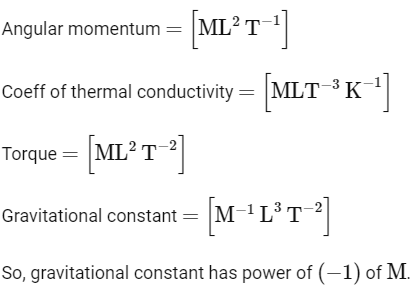
Q4: The errors in the measurement which arise due to unpredictable fluctuations in temperature and voltage supply are: [2023]
(a) Random errors
(b) Instrumental errors
(c) Personal errors
(d) Least count errors
Ans: (a)
- Random errors are errors that occur due to unpredictable fluctuations in external factors such as temperature, voltage supply, or other environmental conditions. These errors vary in magnitude and direction, making them hard to control or predict. They can lead to slight variations in measurements every time an experiment is repeated.
- Instrumental errors are caused by faults in the measuring instruments themselves, such as calibration issues or wear and tear. They are not due to external fluctuations like temperature or voltage.
- Personal errors are caused by human mistakes during measurement or reading, such as misreading an instrument or incorrectly recording data.
- Least count errors are errors due to the limitations of the instrument’s least count or the smallest division that can be measured. These errors are systematic and occur due to the inherent limitations of the measuring device.
Therefore, errors arising from unpredictable fluctuations in temperature and voltage supply are classified as random errors.
Thus, the correct answer is (a) Random errors.
2022
Q1: The physical quantity that has the same dimensional formula as pressure is [2022]
(a) Coefficient of viscosity
(b) Force
(c) Momentum
(d) Young's modulus of elasticity
Ans: (d)
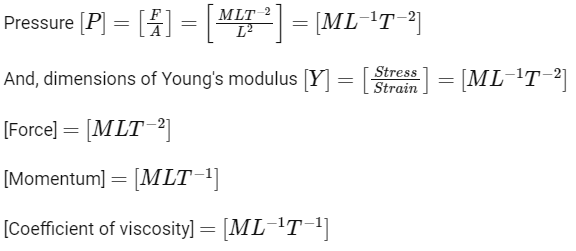
Q2: The percentage error in the measurement of g is : (Given that  ,
,  s) [2022]
s) [2022]
(a) 7%
(b) 2%
(c) 5%
(d) 3%
Ans: (d)
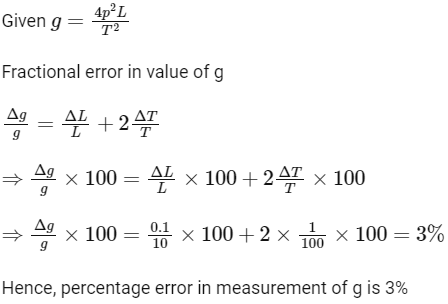
Q3: The dimensions [MLT–2A–2 ] belong to the [2022]
(a) Self-inductance
(b) Magnetic permeability
(c) Electric permittivity
(d) Magnetic flux
Ans: (b)
The dimensional formula of magnetic permeability is [MLT–2A–2 ]
Q4: The area of a rectangular field (in m2 ) of length 55.3 m and breadth 25 m after rounding off the value for correct significant digits is [2022]
(a) 1382
(b) 1382.5
(c) 14 × 102
(d) 138 × 101
Ans: (c)
Area = Length × Breadth
= 55.3 × 25 m2
= 1382.5 m2
= 14 × 102 m2
(Rounding off of two significant figures)
Q5: Match List-I with List-II
Choose the correct answer from the options given below [2022]
(a) (a) - (ii), (b) - (iv), (c) - (i), (d) - (iii)
(b) (a) - (ii), (b) - (iv), (c) - (iii), (d) - (i)
(c) (a) - (iv), (b) - (ii), (c) - (i), (d) - (iii)
(d) (a) - (ii), (b) - (i), (c) - (iv), (d) - (iii)
Ans: (a)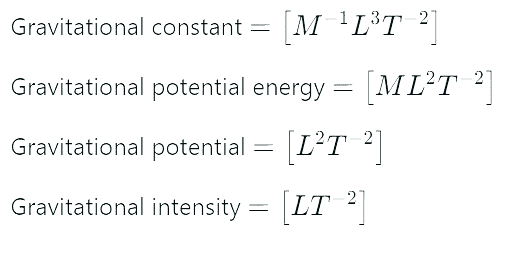
So, the correct answer is option (a).
(a) - (ii), (b) - (iv), (c) - (i), (d) - (iii)
2021
Q1: A Screw Guage gives the following readings when used to measure the diameter of a wire.
Main scale reading = 0.0 mm
Circular scale reading = 52 divisions
Given that: 1 mm on the main scale corresponds to 100 divisions of the circular scale.
The diameter of the wire from the above data is: [2021]
(a) 0.026 cm
(b) 0.005 cm
(c) 0.52 cm
(d) 0.052 cm
Ans: (d)
Diameter of wire,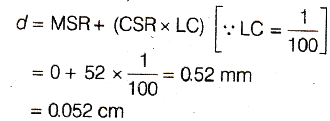
Q2: If force [F], acceleration [A] and time [T] are chosen as the fundamental physical quantities. Find the dimensions of energy. [2021]
(a) [F][A][T-1]
(b) [F][A-1][T]
(c) [F][A][T]
(d) [F][A][T2]
Ans: (d)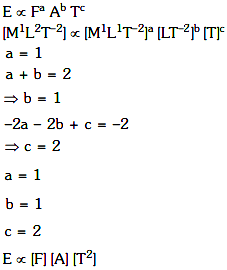
Q3: If E and G respectively denote energy and gravitational constant, then E/G has the dimensions of : [2021]
(a) [M] [L0] [T0]
(b) [M2] [L–2] [T–1]
(c) [M2] [L–1] [T0]
(d) [M] [L–1] [T–1]
Ans: (c)
E = energy = [ML2T–2]
G = Gravitational constant = [M–1L3T–2]
So,
E/G = [E]/[G]
= ML2T–2/M–1L3T–2
= [M2L-1T0]
2020
Q1: A screw gauge has least count of 0.01 mm and there are 50 divisions in its circular scale. [2020]
The pitch of the screw gauge is :
(a) 0.25 mm
(b) 0.5 mm
(c) 1.0 mm
(d) 0.01 mm
Ans: (b)
Least count of screw gauge = 

Q2: Taking into account of the significant figures, what is the value of 9.99 m-0.0099 m? [2020]
(a) 9.980 m
(b) 9.9 m
(c) 9.9801 m
(d) 9.98 m
Ans: (d)
As per rule least no. of place in decimal portion of any number 9.98.
Q3: Dimensions of stress are : [2020]
(a) [ML2T-2]
(b) [ML0T-2]
(c) [ML-1T-2]
(d) [MLT-2]
Ans: (c)
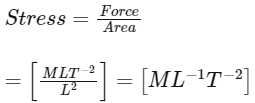
2019
Q1: In an experiment, the percentage of error occurred in the measurement of physical quantities A, B, C and D are 1%, 2%, 3% and 4% respectively. Then the maximum percentage of error in the measurement X, where  will be [2019]
will be [2019]
(a) 
(b) 16 %
(c) -10 %
(d) 10 %
Ans: (b)
Given



= 2% + 1%+ 1%+ 12%= 16%
2018
Q1: A student measured the diameter of a small steel ball using a screw gauge of least count 0.001 cm. The main scale reading is 5 mm and zero of circular scale division coincides with 25 divisions above the reference level. If screw gauge has a zero error of – 0.004 cm, the correct diameter of the ball is :- [2018]
(a) 0.521 cm
(b) 0.525 cm
(c) 0.053 cm
(d) 0.529 cm
Ans: (d)
Solution:
Reading of screw gauge
= MSR + VSR × LC + zero error
= 0.5 cm + 25 × 0.001 cm + 0.004 cm
= 0.529 cm
2017
Q1: A physical quantity of the dimensions of length that can be formed out of  is velocity of light, G is universal constant of gravitation and e is charge] :- [2017]
is velocity of light, G is universal constant of gravitation and e is charge] :- [2017]




Ans: (d)
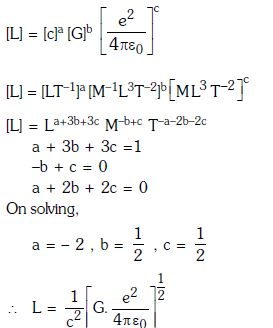
2016
Q1: Planck's constant (h), speed of light in vacuum (c) and Newton's gravitational constant (G) are three fundamental constants. Which of the following combinations of these has the dimension of length ? [2016]
(a) 
(b) 
(c) 
(d) 
Ans: (a)
According to question,
L
[M0LT0] = [ML2T-1]p [LT-1]q [M-1L3T-2]r
Equating power both sides, we get
p - r = 0 ......(1)
2p + q + 3r = 1 ......(2)
- p - q - 2r = 0 ......(3)
Solving equation (1), (2), (3), we get

2015
Q1: If dimensions of critical velocity vc of a liquid flowing through a tube are expressed as  where η,ρ and r are the coefficient of viscosity of liquid, density of liquid and radius of the tube respectively, then the values of x, y and z are given by: [2015]
where η,ρ and r are the coefficient of viscosity of liquid, density of liquid and radius of the tube respectively, then the values of x, y and z are given by: [2015]
(a) 1, −1, −1
(b) 1, 1, 1
(c) 1, −1, −1
(d) −1, −1, 1
Ans: (c)

Put dimensions of various quantities,
[M0LT-1] = [ML-1T-1]x [ML-3T0]y [M0LT0]z
= [Mx + y L- x - 3y + z T- x]
Equating power both sides, we get
x + y = 0;
- x - 3y + z = 1;
- x = - 1
On solving, we get
x = 1, y = -1, z = -1
2014
(a) [F V−1 T−1]
(b) [F V−1 T]
(c) [F V T−1]
(d) [F V T−2]
Ans: (b)

|
96 videos|367 docs|98 tests
|
FAQs on NEET Previous Year Questions (2014-2025): Units & Measurements - Physics Class 11
| 1. What is the concept of physical world in the context of NEET exam? |  |
| 2. How are units important in the field of measurements for the NEET exam? |  |
| 3. What are the common measurement units used in the NEET exam for physical quantities? |  |
| 4. How does understanding the physical world and units help in solving NEET exam questions? |  |
| 5. Why is it important for NEET aspirants to have a strong grasp of the concepts related to physical world, units, and measurements? |  |


